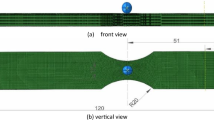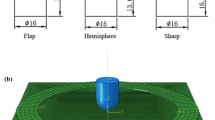Abstract
Recent improvements in manufacturing processes and materials properties associated with excellent mechanical characteristics and low weight have made composite materials very attractive for application on civil aircraft structures. However, even new designs are still very conservative, because the composite failure phenomenon is very complex. Several failure criteria and theories have been developed to describe the damage process and how it evolves, but the solution of the problem is still open. Moreover, modern filament winding techniques have been used to produce a wide variety of structural shapes not only cylindrical parts, but also “flat” laminates. Therefore, this work presents the development of a damage model and its application to simulate the progressive failure of flat composite laminates made using a filament winding process. The damage model was implemented as a UMAT (User Material Subroutine), in ABAQUSTM Finite Element (FE) framework. Progressive failure analyses were carried out using FE simulation in order to simulate the failure of flat filament wound composite structures under different loading conditions. In addition, experimental tests were performed in order to identify parameters related to the material model, as well as to evaluate both the potential and the limitations of the model. The difference between numerical and the average experimental results in a four point bending set-up is only 1.6 % at maximum load amplitude. Another important issue is that the model parameters are not so complicated to be identified. This characteristic makes this model very attractive to be applied in an industrial environment.













Similar content being viewed by others
Abbreviations
- d i , i = 1, 2, 6:
-
Damage variable (1-fibre direction, 2-transverse direction, 6-shear in ply plane)
- E 11 :
-
Current elastic modulus in fibre direction
- \( {E_{{{11_0}}}} \) :
-
Original elastic modulus in fibre direction
- E 22 :
-
Current elastic modulus in transverse direction
- \( {E_{{{22_0}}}} \) :
-
Original elastic modulus in transverse direction
- E D :
-
Strain energy
- E DC :
-
Strain energy critical value
- f :
-
Damage limit surface
- G 12 :
-
Shear modulus in ply plane
- S 12y :
-
Shear linear elastic limit in ply plane
- X T :
-
Tensile strength limit in fibre direction
- Y T :
-
Tensile limit in transverse direction
- Y 2 :
-
Thermodynamic force related to d 2
- Y 6 :
-
Thermodynamic force related to d 6
- X C0 :
-
Compression linear elastic limit in fibre direction
- X C :
-
Compression limit in fibre direction
- Y C0 :
-
Compression linear elastic limit in transverse direction
- Y C :
-
Compression limit in transverse direction
- σ ij :
-
Second order stress tensor
- \( {{\widehat{\sigma}}_{ij }} \) :
-
Second order effective stress tensor
- σ 11 :
-
Stress component in fibre direction
- σ x :
-
Stress component in principal material orientation
- σ 22 :
-
Stress component in transverse direction
- σ 22y :
-
Linear elastic limit for stress in transverse direction
- \( \widehat{\sigma} \) :
-
Effective stress
- τ 12 :
-
Shear stress component in ply plane
- τ xy :
-
Shear stress in principal material orientation
- ε ij :
-
Second order strain tensor
- ε 11 :
-
Strain component in fibre direction
- ε 22 :
-
Strain component in transverse direction
- γ 12 :
-
Shear strain component in ply plane
- v 12 :
-
Major Poisson’s coefficient
- v 21 :
-
Minor Poisson’s coefficient
References
Travessa, A.T.: Simulation of delamination in composites under quasi-static and fatigue loading using cohesive zone models. Ph.D. dissertation, Universitat de Girona (2006)
Li, X., Binienda, W., and Goldberg, R.: Finite-element model for failure study of two-dimensional triaxially braided composite. J. Aerosp. Eng. 24, 170–180 (2011)
Wang, W., Wan, X., Zhou, J., Zhao, M., Li, Y., Shang, S., Gao, X.: Damage and failure of a laminated carbon fibre reinforced composite under low velocity impact. J. Aerosp. Eng. (2012). doi:10.1061/(ASCE)AS.1943-5525.0000243
Puck, A., Schürmann, H.: Failure analysis of FRP laminates by means of physically based phenomenological models. Compos. Sci. Technol. 62(12–13), 1633–1662 (2002)
Maimí, P., Camanho, P.P., Mayugo, J.A., Dávila, C.G.: A continuum damage model for composite laminates: Part I—Constitutive model. Mech. Mater. 39(10), 897–908 (2007)
Yokozeki, T., Ogasawara, T., Ishikawa, T.: Effects of fibre nonlinear properties on the compressive strength prediction of unidirectional carbon-fibre composites. Compos. Sci. Technol. 65(14), 2140–2147 (2005)
Budiansky, B., Fleck, N.A.: Compressive failure of fibre composites. J. Mech. Phys. Solid. 41(1), 183–211 (1993)
Reid, S.R., Zhou, G.: Impact behaviour of fibre-reinforced composite materials and structures. Cornwall: CRC Press. (2000)
Donadon, M.V., Frascino, S.M., Arbelo, M.A., Faria, A.R.: A three-dimensional ply failure model for composite structures. Int. J. Aero. Eng. 200(9), 22 (2009)
Pavan, R.C., Oliveira, B.F., Maghous, S., Creus, G.J.: A model for anisotropic viscoelastic damage in composites. Compos. Struct. 92(5), 1223–1228 (2010)
Flatscher, T., Pettermann, H.E.: A constitutive model for fibre-reinforced polymer plies accounting for plasticity and brittle damage including softening—Implementation for implicit FEM. Compos. Struct. 93(9), 2241–2249 (2011)
Lubineau, G., Ladeveze, P.: Construction of a micromechanics-based intralaminar mesomodel, and illustrations in ABAQUS/Standard. Comput. Mater. Sci. 43, 137–145 (2008)
Lubineau, G.: A pyramidal modelling scheme for laminates—identification of transverse cracking. Int. J. Damage Mech. 19(4), 499–518 (2010)
Callister, W.D., Rethwisch, D.G.: Fundamentals of materials science and engineering. New York: John Wiley & Sons, Inc. (2011)
Ribeiro, M.L., Tita, V., Vandepitte, D.: A new damage model for composite laminates. Compos. Struct. 94(2), 635–642 (2012)
Herakovich, C.T.: Mechanics of fibrous composites. New York: John Wiley & Sons, Inc. (1998)
Kachanov, L.M.: Introduction to Continuum Damage Mechanics. Martinus Nijhoff Publishers, Dordrecht (1986)
Matzenmiller, A., Lubliner, J., Taylor, R.L.: A constitutive model for anisotropic damage in fibre-composites. Mech. Mater. 20(2), 125–152 (1995)
Besnard, G., Hild, F., Roux, S.: “Finite-element” displacement fields analysis from digital images: application to portevin-Le châtelier bands. Exp. Mech. 46(6), 789–804 (2006)
American Society for Testing and Materials D3039: Standard test method for tensile properties of polymer matrix composite materials. Philadelphia (2006)
American Society for Testing and Materials D790: Standard test methods for flexural properties of unreinforced and reinforced plastics and electrical insulating materials. Philadelphia (2008)
Yokozeki, T., Ogasawara, T., Ishikawa, T.: Nonlinear behaviour and compressive strength of unidirectional and multidirectional carbon fibre composite laminates. Compo. A Appl. Sci. Manuf. 37(11), 2069–2079 (2006)
Ladeveze, P., LeDantec, E.: Damage modelling of the elementary ply for laminated composites. Compos. Sci. Technol. 43(3), 257–267 (1992)
Lemaitre, J., Desmorat, R.: Engineering damage mechanics: ductile, creep, fatigue and brittle failures. Heidelberg Springer. (2005)
Allix, O., Ladevèze, P., Vittecoq, E.: Modelling and identification of the mechanical behaviour of composite laminates in compression. Compos. Sci. Technol. 51(1), 35–42 (1994)
Acknowledgments
The authors are grateful for the support from CTM (Navy Technological Centre – Brazil), São Paulo Research Foundation (FAPESP process number: 2009/00544-5), National Council of Research (CNPq process number: 208137/2012-2), AFOSR and US-Army (Grant/Contract Number: FA9550-10-1-0011). The authors also would like to thank Prof. Reginaldo Teixeira Coelho (Engineering School of São Carlos – University of São Paulo) for the ABAQUSTM license.
Author information
Authors and Affiliations
Corresponding author
Rights and permissions
About this article
Cite this article
Ribeiro, M.L., Vandepitte, D. & Tita, V. Damage Model and Progressive Failure Analyses for Filament Wound Composite Laminates. Appl Compos Mater 20, 975–992 (2013). https://doi.org/10.1007/s10443-013-9315-x
Received:
Accepted:
Published:
Issue Date:
DOI: https://doi.org/10.1007/s10443-013-9315-x




